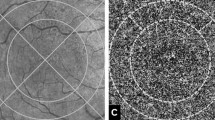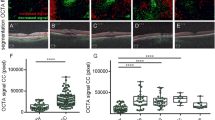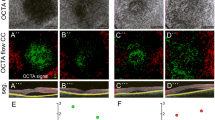Abstract
Purpose
To evaluate if choriocapillaris (CC) vessel density and CC decorrelation signal index are compromised in eyes with reticular pseudodrusen (RPD) using optical coherence tomography angiography (OCT-A).
Methods
Decorrelation values in OCT-A CC images of 20 RPD patients were measured in the outer superior and the outer inferior sector of the EDTRS grid and compared to age-matched healthy controls. CC vessel density and CC decorrelation signal index were measured within a 30 μm and a 10 μm OCT-A CC slab. CC data were correlated to number of RPD lesions, predominantly present RPD stage, predominantly present RPD type, retinal area affected by RPD and choroidal thickness (CT).
Results
CC vessel density and CC decorrelation signal index decreased in correlation to advancing age in healthy subjects particularly in subjects older than 60 years (CC vessel density: 30 μm: p=0.0019; 10 μm: p=0.0014; CC decorrelation signal index: 30 μm: p=0.0005; 10 μm: p=0.0003). In the RPD group, CC vessel density (outer superior sector, 10 μm: 98.299) and CC decorrelation signal index (89.07) were significantly reduced compared to controls (99.203, p=0.0002; 98.09, p=0.0010). The number of RPD lesions was correlated to a reduced CC vessel density (30 μm: p=0.0355) but not to changes in CC decorrelation signal index. No correlations were found between CC parameters and either RPD stage, RPD type, size of RPD affected area or CT.
Conclusions
OCT-A reveals a distinct reduction in CC vessel density and CC decorrelation signal index in eyes affected by RPD, which emphasizes the relevance of the CC layer in RPD pathogenesis.




Similar content being viewed by others
References
Zweifel SA, Imamura Y, Spaide TC et al (2010) Prevalence and significance of subretinal drusenoid deposits (reticular pseudodrusen) in age-related macular degeneration. Ophthalmology 117:1775–1781
Klein R, Meuer SM, Knudtson MD et al (2008) The epidemiology of retinal reticular drusen. Am J Ophthalmol 145:317–326
Alten F, Clemens CR, Milojcic C et al (2012) Subretinal drusenoid deposits associated with pigment epithelium detachment in age-related macular degeneration. Retina 32:1727–1732
Cohen SY, Dubois L, Tadayoni R et al (2007) Prevalence of reticular pseudodrusen in age-related macular degeneration with newly diagnosed choroidal neovascularisation. Br J Ophthalmol 91:354–359
Finger RP, Wu Z, Luu CD et al (2014) Reticular pseudodrusen: a risk factor for geographic atrophy in fellow eyes of individuals with unilateral choroidal neovascularization. Ophthalmology 121:1252–1256
Marsiglia M, Boddu S, Bearelly S et al (2013) Association between geographic atrophy progression and reticular pseudodrusen in eyes with dry age-related macular degeneration. Invest Ophthalmol Vis Sci 54:7362–7369
Schmitz-Valckenberg S, Alten F, Steinberg JS, Geographic Atrophy Progression (GAP) Study Group et al (2011) Reticular drusen associated with geographic atrophy in age-related macular degeneration. Invest Ophthalmol Vis Sci 52:5009–5015
Ooto S, Suzuki M, Vongkulsiri S et al (2015) Multimodal visual function testing in eyes with nonexudative age-related macular degeneration. Retina 35:1726–1734
Querques G, Massamba N, Srour M et al (2014) Impact of reticular pseudodrusen on macular function. Retina 34:321–329
Ooto S, Ellabban AA, Ueda-Arakawa N et al (2013) Reduction of Retinal Sensitivity in Eyes With Reticular Pseudodrusen. Am J Ophthalmol 156:1184–1191
Forte R, Cennamo G, de Crecchio G et al (2014) Microperimetry of subretinal drusenoid deposits. Ophthalmic Res 51:32–36
Steinberg JS, Fitzke FW, Fimmers R et al (2015) Scotopic and Photopic Microperimetry in Patients With Reticular Drusen and Age-Related Macular Degeneration. JAMA Ophthalmol 133:690–697
Alten F, Heiduschka P, Clemens CR, Eter N (2012) Multifocal electroretinography in eyes with reticular pseudodrusen. Invest Ophthalmol Vis Sci 53:6263–6270
Alten, Heiduschka P, Clemens CR, Eter N (2014) Longitudinal structure / function analysis in reticular pseudodrusen. Invest Ophthalmol Vis Sci 55:6073–6081
Flamendorf J, Agrón E, Wong WT et al (2015) Impairments in Dark Adaptation Are Associated with Age-Related Macular Degeneration Severity and Reticular Pseudodrusen. Ophthalmology 122:2053–2062
Curcio CA, Messinger JD, Sloan KR et al (2013) Subretinal drusenoid deposits in non-neovascular age-related macular degeneration: morphology, prevalence, topography, and biogenesis model. Retina 33:265–276
Gliem M, Müller PL, Mangold E et al (2015) Reticular Pseudodrusen in Sorsby Fundus Dystrophy. Ophthalmology 122:1555–1562
Gliem M, Hendig D, Finger RP et al (2015) Reticular pseudodrusen associated with a diseased bruch membrane in pseudoxanthoma elasticum. JAMA Ophthalmol 133:581–588
Zweifel SA, Imamura Y, Freund KB, Spaide RF (2011) Multimodal fundus imaging of pseudoxanthoma elasticum. Retina 31:482–491
Sarks JP, Sarks SH, Killingsworth MC (1988) Evolution of Geographic Atrophy of the Retinal-Pigment Epithelium. Eye (Lond) 2:552–577
McLeod DS, Grebe R, Bhutto I et al (2009) Relationship between RPE and Choriocapillaris in Age-Related Macular Degeneration. Invest Ophthalmol Vis Sci 50:4982–4991
Mullins RE, Johnson MN, Faidley EA et al (2011) Choriocapillaris Vascular Dropout Related to Density of Drusen in Human Eyes with Early Age-Related Macular Degeneration. Invest Ophthalmol Vis Sci 52:1606–1612
Biesemeier A, Taubitz T, Julien S et al (2014) Choriocapillaris breakdown precedes retinal degeneration in age-related macular degeneration. Neurobiol Aging 35:2562–2573
Jia Y, Tan O, Tokayer J et al (2012) Split-spectrum amplitude-decorrelation angiography with optical coherence tomography. Opt Express 20:4710–4725
Jia Y, Bailey ST, Hwang TS et al (2015) Quantitative optical coherence tomography angiography of vascular abnormalities in the living human eye. Proc Natl Acad Sci U S A 112:E2395–2402
Sohrab MA, Smith RT, Salehi-Had H et al (2011) Image registration and multimodal imaging of reticular pseudodrusen. Invest Ophthalmol Vis Sci 52:5743–5748
Querques G, Querques L, Forte R et al (2012) Choroidal Changes Associated with Reticular Pseudodrusen. Invest Ophthalmol Vis Sci 53:1258–1263
Smith RT, Sohrab MA, Busuioc M, Barile G (2009) Reticular macular disease. Am J Ophthalmol 148:733–743
Garg A, Oll M, Yzer S et al (2013) Reticular Pseudodrusen in Early Age-Related Macular Degeneration is Associated with Choroidal Thinning. Invest Ophthalmol Vis Sci 54:7075–7081
Alten F, Clemens CR, Heiduschka P, Eter N (2013) Localized reticular pseudodrusen and their topographic relation to choroidal watershed zones and changes in choroidal volumes. Invest Ophthalmol Vis Sci 54:3250–3257
Fujiwara T, Imamura Y, Margolis R et al (2009) Enhanced depth imaging optical coherence tomography of the choroid in highly myopic eyes. Am J Ophthalmol 148:445–450
Alten F, Eter N (2015) Current knowledge on reticular pseudodrusen in age-related macular degeneration. Br J Ophthalmol 99:717–722
Ramrattan RS, van der Schaft TL, Mooy CM et al (1994) Morphometric analysis of Bruch’s membrane, the choriocapillaris, and the choroid in aging. Invest Ophthalmol Vis Sci 35:2857–2864
Pechauer AD, Jia Y, Liu L et al (2015) Optical Coherence Tomography Angiography of Peripapillary Retinal Blood Flow Response to Hyperoxia. Invest Ophthalmol Vis Sci 56:3287–3291
Querques G, Canouï-Poitrine F, Coscas F et al (2012) Analysis of progression of reticular pseudodrusen by spectral domain-optical coherence tomography. Invest Ophthalmol Vis Sci 53:1264–1270
Zweifel SA, Spaide RF, Curcio CA et al (2010) Reticular Pseudodrusen Are Subretinal Drusenoid Deposits. Ophthalmology 117:303–312
Suzuki M, Sato T, Spaide RF (2014) Pseudodrusen subtypes as delineated by multimodal imaging of the fundus. Am J Ophthalmol 157:1005–1012
Schmitz-Valckenberg S, Bindewald-Wittich A, Dolar-Szczasny J et al (2006) Correlation between the area of increased autofluorescence surrounding geographic atrophy and disease progression in patients with AMD. Invest Ophthalmol Vis Sci 47:2648–2654
McLeod DS, Lutty GA (1994) High-resolution histologic analysis of the human choroidal vasculature. Invest Ophthalmol Vis Sci 35:3799–3811
Kurokawa K, Sasaki K, Makita S, Hong Y-J, Yasuno Y (2012) Threedimensional retinal and choroidal capillary imaging by power Doppler optical coherence angiography with adaptive optics. Opt Express 20:22796–22812
Braaf B, Vienola KV, Sheehy CK et al (2013) Realtime eye motion correction in phase-resolved OCT angiography with tracking SLO. Biomed Opt Express 4:51–65
Choi W, Mohler KJ, Potsaid B et al (2013) Choriocapillaris and choroidal microvasculature imaging with ultrahigh speed OCT angiography. PLoS ONE 8(12), e81499
Kraus MF, Potsaid B, Mayer MA et al (2012) Motion correction in optical coherence tomography volumes on a per A-scan basis using orthogonal scan patterns. Biomed Opt Express 3:1182–1199
Kraus MF, Liu JJ, Schottenhamml J et al (2014) Quantitative 3D-OCT motion correction with tilt and illumination correction, robust similarity measure and regularization. Biomed Opt Express 5:2591–2613
Spaide RF, Fujimoto JG, Waheed NK (2015) Image artifacts in optical coherence tomography angiography. Retina 35:2163–80
Author information
Authors and Affiliations
Corresponding author
Ethics declarations
Author Disclosure Information
F. Alten, Bayer; P. Heiduschka, Bayer, Novartis; C.R. Clemens, Heidelberg Engineering, Novartis, Bayer; N. Eter, Heidelberg Engineering, Novartis, Bayer, Sanofi Aventis, Allergan, Bausch and Lomb.
Funding
No funding was received for this research.
Conflict of Interest
All authors certify that they have no affiliations with or involvement in any organization or entity with any financial interest (such as honoraria; educational grants; participation in speakers’ bureaus; membership, employment, consultancies, stock ownership, or other equity interest; and expert testimony or patent-licensing arrangements), or non-financial interest (such as personal or professional relationships, affiliations, knowledge or beliefs) in the subject matter or materials discussed in this manuscript.
Ethical approval
All procedures performed in studies involving human participants were in accordance with the ethical standards of the institutional and/or national research committee and with the 1964 Helsinki declaration and its later amendments or comparable ethical standards.
Informed consent
Informed consent was obtained from all individual participants included in the study.
Rights and permissions
About this article
Cite this article
Alten, F., Heiduschka, P., Clemens, C.R. et al. Exploring choriocapillaris under reticular pseudodrusen using OCT-Angiography. Graefes Arch Clin Exp Ophthalmol 254, 2165–2173 (2016). https://doi.org/10.1007/s00417-016-3375-1
Received:
Revised:
Accepted:
Published:
Issue Date:
DOI: https://doi.org/10.1007/s00417-016-3375-1




